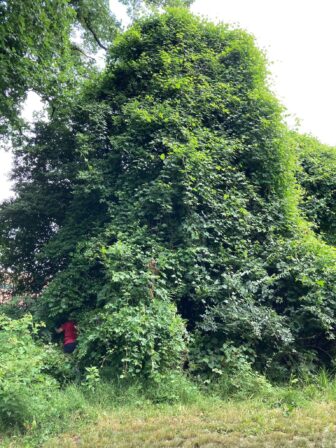Trees and forests in both urban and rural settings already face myriad threats. Among these is the threat of NNI (Non-Native Invasive) plants. NNIs cause significant changes in the composition, structure, and ecosystem function of our natural areas. Of particular concern are NNI vines which impact trees – and ecosystems – in a few fundamental ways by:
- Smothering trees and shrubs, blocking light to their leaves;
- Shading and out-competing low growing plants;
- Inhibiting wildlife movement;
- Making trees more vulnerable to blowing over in storms due to their added weight; and,
- Climbing, twisting, and strangling trees and shrubs, eventually girdling and killing them by cutting off the flow of water and nutrients
NNIs, including vines, tend to have faster growth rates than their native counterparts. Many are evergreen, or tend to leaf-out early in the spring – or keep their leaves longer in the fall – allowing them to take advantage of longer growing seasons. Many NNIs are resistant to drought and are able to grow in a variety of soil conditions and shade levels. NNIs also have highly effective reproductive and dispersal mechanisms; many are capable of spreading vegetatively (by rhizomes) and by seeds, while others can produce new plants from tiny root fragments. Most NNIs produce abundant fruit and seeds that are widely dispersed and remain viable in the soil for years. Many also store energy in extensive root systems and can sprout back repeatedly after cutting.
Invasive plants also lack natural controls, or predators, which also allows them to establish and take over an area quickly. This means that NNIs quickly replace native food sources for wildlife, altering the abundance and diversity of native species and the composition of entire ecosystems. All of these factors make it extremely difficult for our native plants to compete.
Invasive plant species and climate change together present a double-edged threat to trees: invasive plant species appear to take advantage of warming trends and climate change will put further stress on trees that are already disadvantaged by climate-related shocks. This is of particular concern in the DC region which witnessed numerous fatalities of mature oak trees over the past two years.


